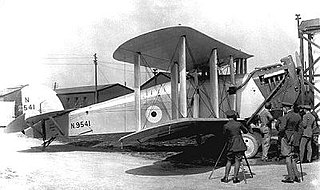
The Hawker Harrier was an experimental biplane torpedo bomber aircraft built by Hawker Aircraft to a specification issued in the 1920s for the RAF.

The Douglas DT bomber was the Douglas Aircraft Company's first military contract, forging a link between the company and the United States Navy. Navy Contract No. 53305 of April 1, 1921, required only 18 pages to set out the specifications that resulted in the purchase of three DT folding-wing aircraft.

The Boeing XF6B-1 / XBFB-1 was Boeing's last biplane design for the United States Navy. Only the one prototype, Model 236, was ever built; although first flying in early 1933, it rammed into a crash barrier in 1936 and the design was not pursued further.

The Yokosuka B4Y,, carrier torpedo bomber was used by the Imperial Japanese Navy Air Service from 1936 to 1943. The B4Y replaced the Mitsubishi B2M2 and was the last biplane bomber used operationally by the Imperial Japanese Navy. The Allied reporting name was "Jean".

The Blackburn Dart was a British carrier-based torpedo bomber biplane, manufactured by Blackburn Aircraft, which first flew in 1921. The Dart was the standard single-seat torpedo bomber used by the Fleet Air Arm from 1923 until 1933. A modified variant was also sold to Greece, where they served with the Greek Navy.

The Caudron R.4 was a French World War I twin-engine biplane reconnaissance/artillery cooperation aircraft and the progenitor of a series of successful aircraft that filled a variety of roles with the French Aéronautique Militaire.
The Potez XV was a French single-engine, two-seat observation biplane designed as a private venture by Louis Coroller and built by Potez and under licence in Poland.

The Lioré et Olivier LéO 7 was a French bomber escort biplane designed and built by Lioré et Olivier for the French Air Force.

The Gotha WD.11 was a torpedo bomber seaplane developed in Germany during World War I. When the general configuration of the Gotha WD.7 proved promising, Gotha set to work designing a much larger and more powerful aircraft along the same general lines. Like its predecessor, it was a conventional biplane with twin engines mounted tractor-fashion on the lower wing. The pilot and observer sat in tandem, open cockpits and the landing gear consisted of twin pontoons. 12 examples were built for the Imperial German Navy.

The Gotha WD.14, WD.20, and WD.22 were a family of biplane torpedo bomber floatplanes developed in Germany during World War I.

The Levasseur PL.5 was a carrier-based fighter produced in France in the late 1920s, in response to the 1924 AMBC.2 specification issued by the Service Technique de l'Aéronautique (STAé). It was a conventional, single-bay sesquiplane that carried a crew of two in tandem, open cockpits. Like other Levasseur naval designs of the day, it incorporated several safety features in case of ditching at sea. Apart from small floats attached directly to the undersides of the lower wing, the main units of the fixed, tail-skid undercarriage could be jettisoned in flight, and the underside of the fuselage was given a boat-like shape and made watertight.

The Levasseur PL.6 C.2, also known as Levasseur VI C.2, was a two-seat fighter aircraft built in France in 1926 in order to meet a 1925 C.2 Service Technique de l'Aéronautique (STAé) specification,. Constructed along the same lines as Levasseur's naval aircraft of the same era, it was a conventional, single-bay biplane with seating for the pilot and tail gunner in separate, open cockpits. Flight testing of the prototype commenced in 1926, and it was exhibited at the Salon de l'Aéronautique at the end of the year.

The Levasseur PL.7 was a torpedo bomber developed in France in the late 1920s. It was a development of Levasseur's PL.4 reconnaissance aircraft and intended to replace their PL.2 then in service with the Aéronavale. It was a single-bay biplane of largely conventional design, but incorporating safety features for naval operation, including jetissonable main undercarriage units, a watertight, boat-shaped fuselage, and small floats on the undersides of the lower wings.

The Levasseur PL.10 was a carrier-based reconnaissance aircraft developed in France in the late 1920s. It was a conventional, single-bay biplane along similar lines to Levasseur's contemporary designs for the French navy, including a watertight, boat-shaped fuselage, small underwing floats, and undercarriage that could be jettisoned in flight in order to improve the changes of a successful ditching.

The Villiers II was a French two-seat fighter aircraft of the 1920s intended for operation from the Aircraft carrier Béarn of the French Navy. It was a single-engined tractor biplane with a waterproof hull in the form of a flying boat to allow the aircraft to be safely landed on water in an emergency. Two prototypes and 30 production aircraft were built, the type serving briefly with the French Navy, although never operated from an aircraft carrier.
The Farman F.270 was a prototype French bomber/torpedo-bomber designed and built by the Farman Aviation Works for the French Air Force.

The Mitsubishi 3MT5 was a Japanese bomber of the 1930s. It was a twin-engined biplane that was intended to operate from Japanese aircraft carriers, but proved to be unsuitable for carrier use, and the eleven aircraft built were instead used as land-based trainers.
The Borel-Odier Bo-T was a French twin-engined float biplane designed by Borel but built by Antoine Odier for the French Navy.
The Blériot 67 was a First World War French heavy bomber designed and built by Blériot for a 1916 competition Concours des Avions Puissants. Only a single prototype was built.
The Levasseur PL.3 AM3 was a carrier-based reconnaissance aircraft produced in France in the 1920s to fulfill a specification for a three-seat carrier-borne reconnaissance aircraft. The PL.3 AM3, a biplane of all-wood construction did not enter production and only the prototype was built.















